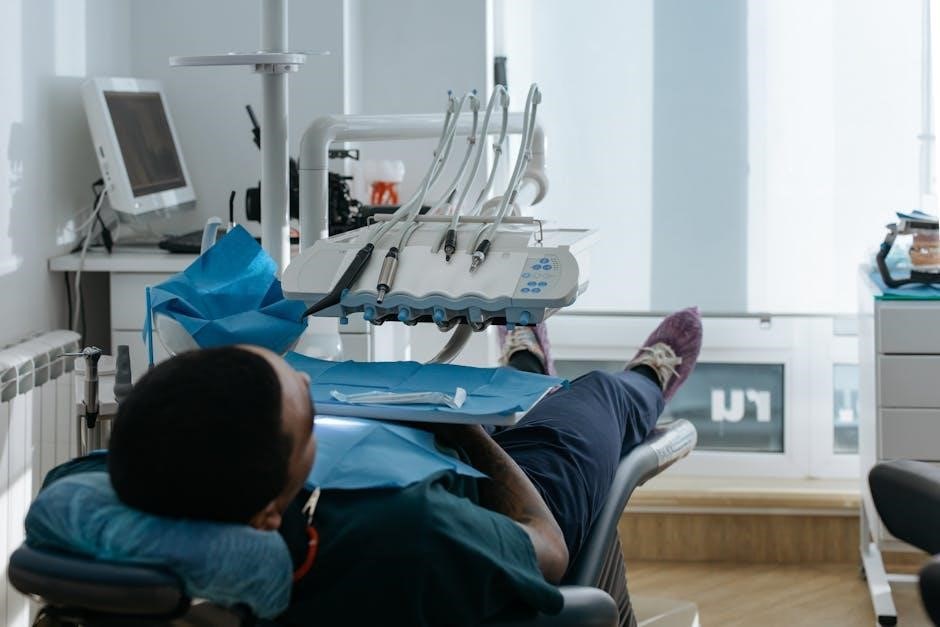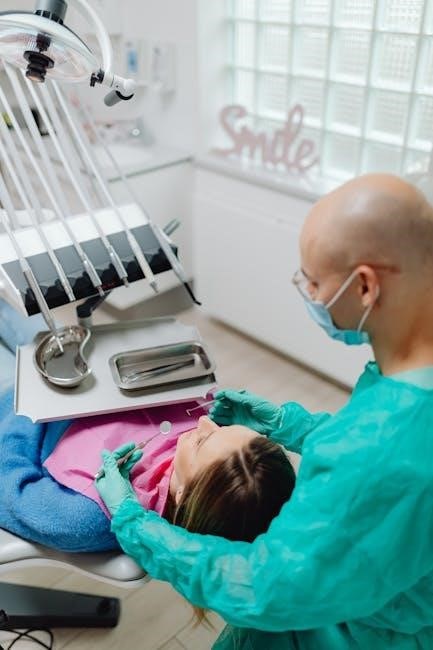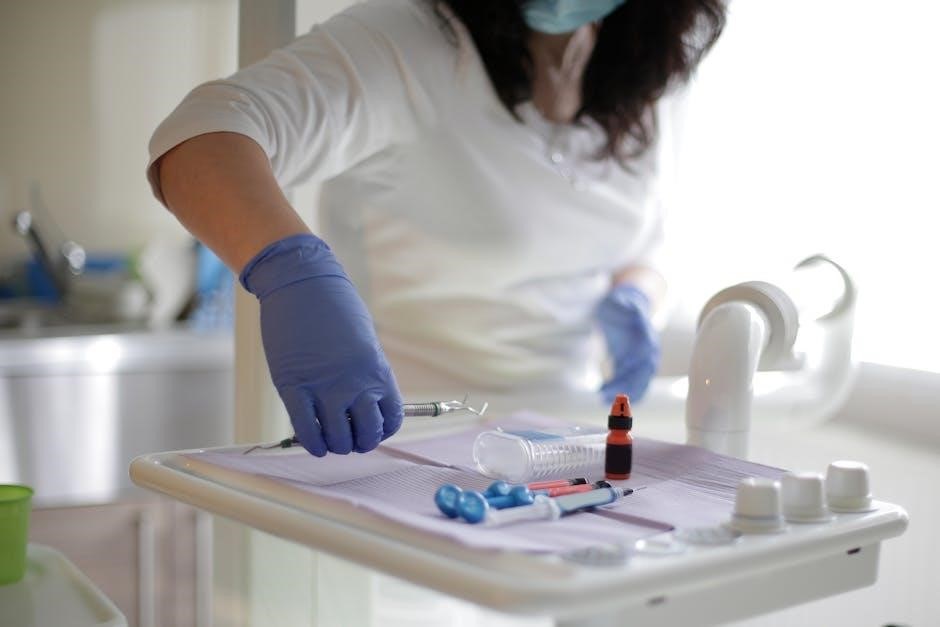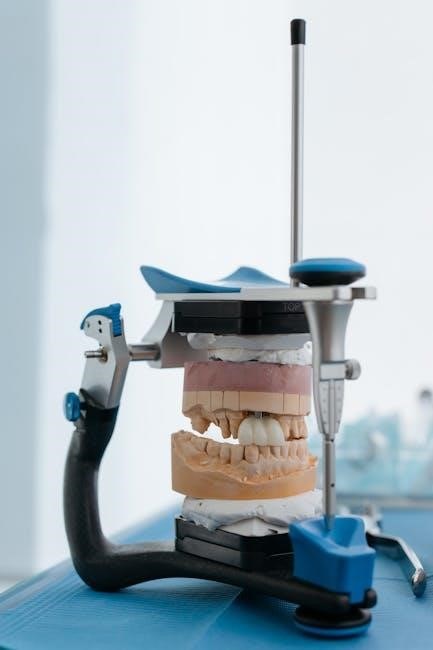Dental Instruments: Names and Pictures (PDF Guide)
This guide will delve into dental instrument names and pictures within a PDF format, offering detailed insights into their functions and applications in dental practice. We’ll explore essential dental tools.
Dental instruments are indispensable tools wielded by dental professionals to meticulously examine, skillfully restore, and, when necessary, extract teeth, along with the intricate surrounding structures. This comprehensive guide will explore the specific names and corresponding visuals of these instruments, providing a detailed understanding of their functions and applications within the realm of dental practice. From basic examination tools to advanced surgical implements, each instrument plays a vital role in delivering comprehensive oral healthcare. Understanding the purpose and functionality of each instrument is crucial for dental professionals to provide optimal patient care. This guide provides a brief overview of these tools to dentists.
Basic Dental Examination Instruments
Standard instruments are used for examination. Before making cavity in patients mouth, dentists examine the patient with examination instruments to see if there any carious region or stained area.
Mouth Mirror
The mouth mirror is a fundamental tool in any dental practice. Its primary functions include providing indirect vision, which allows the dentist to see areas of the mouth that are otherwise difficult to access directly. Additionally, it is used to retract soft tissues such as the lips, cheeks, and tongue, providing a clear field of view. This retraction is essential for thorough examination and treatment. Mouth mirrors come in various sizes and designs, catering to different procedures and preferences. They are typically made with a reflective surface that can be either front-surfaced or back-surfaced, each offering different levels of image clarity.
Dental Probe/Explorer
The dental probe, also known as an explorer, is an essential diagnostic instrument used to detect and assess the condition of teeth. Its primary function is to examine the surfaces of teeth for abnormalities, such as caries (cavities) and other structural defects. The explorer typically has a sharp, pointed tip that allows the dentist to feel for subtle changes in the enamel. This tactile feedback is crucial for identifying early stages of decay before they become visible. Dental probes come in various shapes and sizes, each designed for specific areas of the mouth and types of examinations. They are indispensable tools for comprehensive dental assessments.
Tweezers (Cotton Pliers)
Dental tweezers, often referred to as cotton pliers, are crucial instruments used for grasping and manipulating small objects within the oral cavity during dental procedures. These tweezers are designed with angled or straight beaks to provide precise control and accessibility in tight spaces. Their primary functions include placing and removing cotton rolls, gauze, and other absorbent materials used to keep the treatment area dry. Additionally, tweezers are employed to handle small instruments, medications, and restorative materials. The tips of dental tweezers are typically serrated or smooth to ensure a secure grip without damaging delicate tissues or materials. Available in different sizes and designs, these instruments are indispensable for maintaining a clean and efficient working environment during various dental treatments.

Hygiene Instruments
Hygiene instruments play a vital role in maintaining oral health by removing plaque, calculus, and debris from teeth. These tools, including scalers and curettes, ensure effective cleaning and prevention of dental diseases.
Scalers
Scalers are essential hygiene instruments used in dentistry to remove calculus and plaque from tooth surfaces. These instruments come in various shapes and sizes, each designed for specific areas of the mouth. Sickle scalers, with their sharp, pointed tips, are effective for removing supragingival calculus. Curettes, on the other hand, have rounded toes and are used subgingivally to remove calculus from the root surfaces.
Proper angulation and technique are crucial when using scalers to avoid damaging the tooth structure or soft tissues. Regular use of scalers by dental professionals helps maintain optimal oral health and prevent periodontal disease. Their precision tips, often crafted with high-quality stainless steel, ensure effective and safe calculus removal.
Curettes
Curettes are indispensable hygiene instruments designed for meticulous subgingival scaling and root planing. Unlike scalers with pointed tips, curettes feature rounded toes, enabling safe and effective removal of calculus and plaque from root surfaces without damaging the gingival tissues. Universal curettes can be adapted for use on all tooth surfaces, while area-specific curettes, such as Gracey curettes, are designed to treat specific areas of the mouth with optimal precision.
Their design allows dental professionals to navigate the contours of the tooth roots, ensuring thorough debridement and promoting periodontal health. Proper technique and angulation are essential to prevent tissue trauma and achieve desired outcomes in periodontal therapy.

Operative Instruments
Operative instruments are essential for restorative dental procedures. These tools help prepare teeth, place fillings, and shape dental materials. Key instruments include amalgam carriers and condensers, crucial for amalgam restorations.
Amalgam Carrier
The amalgam carrier is an operative dental instrument designed to efficiently carry and dispense amalgam material into a prepared tooth cavity. This instrument typically features a hollow cylinder with a plunger mechanism. The dentist uses the carrier to scoop up the mixed amalgam, then transports it to the tooth. By depressing the plunger, the amalgam is ejected into the prepared space.
Amalgam carriers come in various sizes to accommodate different cavity dimensions. Proper use ensures accurate placement of the restorative material, contributing to the longevity and success of the amalgam filling. This instrument is crucial for efficient and precise amalgam restorations in dental practices, ensuring quality patient care and effective treatment outcomes. Its design focuses on ease of use and control during the filling process.
Amalgam Condenser (Plugger)
The amalgam condenser, also known as a plugger, is an operative dental instrument used to compact amalgam material into a prepared tooth cavity. This instrument typically features a flat working end, available in various shapes and sizes, attached to a handle. The dentist applies firm pressure with the condenser to pack the amalgam tightly against the cavity walls and floor, eliminating voids and ensuring a dense, well-adapted restoration.
Proper condensation is crucial for the strength and longevity of the amalgam filling. The plugger’s design allows for controlled force application, contributing to the overall success of the restoration. Different condenser sizes and shapes are selected based on the cavity’s dimensions and location. Efficient condensation minimizes the risk of microleakage and ensures a durable, functional filling.

Surgical Instruments
Surgical instruments are essential for various dental procedures, including extractions and implant placements. These instruments are designed for precision, ensuring successful outcomes in complex surgical interventions and procedures.
Dental Forceps
Dental forceps are specialized pliers designed for extracting teeth. Available in various shapes and sizes, they are adapted to grasp different teeth effectively. These surgical instruments feature handles for a secure grip and beaks contoured to match the tooth’s anatomy, ensuring optimal force distribution during extraction. Forceps are vital for removing teeth damaged by decay, trauma, or impaction.
Different types of dental forceps exist, including those for upper and lower teeth, as well as specific designs for molars, premolars, and incisors. Proper selection and technique are crucial to minimize trauma to surrounding tissues and ensure a smooth extraction process. Sterilization protocols are essential to prevent infection.
Periosteal Elevator
A periosteal elevator is a surgical instrument used to lift the periosteum (the membrane covering bone) away from the bone surface. This elevation is essential for accessing the underlying bone during surgical procedures, such as tooth extractions, implant placement, or bone grafting. The instrument typically features a handle and a flat, rounded blade that is carefully inserted between the periosteum and bone.
Periosteal elevators come in various shapes and sizes to accommodate different anatomical areas and surgical needs. Proper use of this instrument minimizes trauma to the periosteum and promotes optimal healing. It is a crucial tool in oral and maxillofacial surgery.
Dental Elevators
Dental elevators are surgical instruments designed to loosen and extract teeth. They are used to luxate the tooth from its socket, severing the periodontal ligaments that hold it in place. Elevators come in various shapes and sizes, including straight, curved, and angled designs, each suited for different teeth and extraction approaches.
The instrument’s working end is carefully inserted between the tooth and the bone, using a controlled rocking or levering motion to gradually dislodge the tooth. Elevators are essential in facilitating atraumatic extractions, preserving surrounding bone and tissues. Cryer elevators are a type of dental elevator.

Dental Imaging Instruments
Dental imaging instruments play a crucial role in diagnostics. They allow dentists to visualize structures not visible during an oral exam. These instruments are essential for accurate treatment planning.
Digital Sensor
The digital sensor represents a modern advancement in dental imaging, replacing traditional X-ray films. Its primary function is to capture digital images of teeth and surrounding structures, offering several advantages over conventional methods. These sensors are designed for intraoral placement, directly capturing the radiographic image within the patient’s mouth.
One key characteristic is their ability to provide instant image viewing, eliminating the need for film development and reducing patient exposure to radiation. Digital sensors also offer enhanced image quality, allowing for detailed visualization of dental anatomy and pathology. This technology improves diagnostic accuracy and treatment planning capabilities in modern dental practices. The use of digital sensors contributes to a more efficient and patient-friendly dental experience, facilitating better oral health care.
Other Essential Instruments
Beyond the core tools, dental practices rely on other essential instruments. These instruments are indispensable for daily procedures. They enhance efficiency, patient comfort, and the overall quality of dental care provided by professionals.
Air/Water Syringe Tip
The air/water syringe tip is a vital dental instrument used to rinse and dry specific teeth or areas within the oral cavity during dental procedures. It is a disposable plastic tip designed for single-patient use, ensuring optimal hygiene and preventing cross-contamination. This instrument attaches to the air/water syringe on the dental unit, providing a controlled stream of air, water, or a combination of both.
The air function is crucial for drying teeth, which enhances visibility and allows for better adhesion of dental materials. The water function is essential for rinsing away debris, such as saliva, blood, and etchants. The combined air and water stream helps to clear the operating field and maintain a clean working environment. The air/water syringe tip contributes to efficient and effective dental treatments.
Low Velocity Saliva Evacuation (LVE)
The Low Velocity Saliva Evacuation (LVE), also known as the saliva ejector, is an essential dental instrument used to remove fluids from the oral cavity during dental procedures. It evacuates reduced volumes of fluid, such as saliva, blood, and water, at a lower suction pressure compared to the high-volume evacuator (HVE). Typically made of disposable plastic for single-patient use, the LVE minimizes the risk of cross-contamination.
The LVE can be bent or used straight, allowing for flexible positioning within the mouth to effectively remove fluids. Connected to tubing on the dental unit, it ensures a clear operating field, enabling the dentist to work efficiently and maintain patient comfort. Its gentle suction makes it suitable for patients of all ages, including children and those with sensitive tissues. The LVE plays a crucial role in maintaining a dry and clean environment.